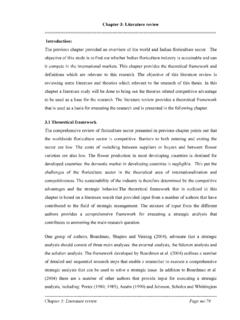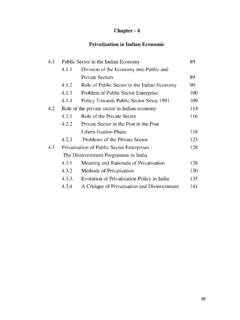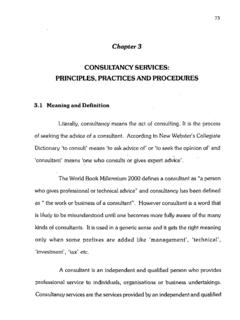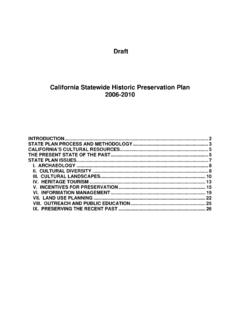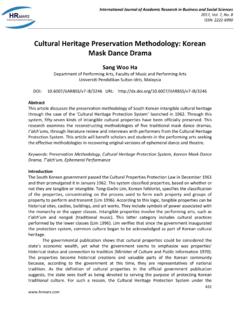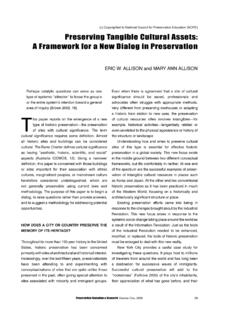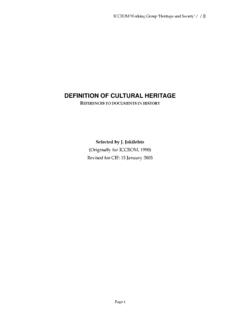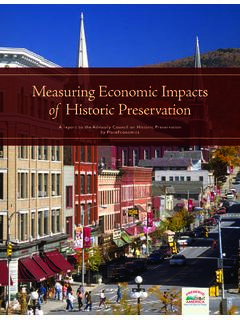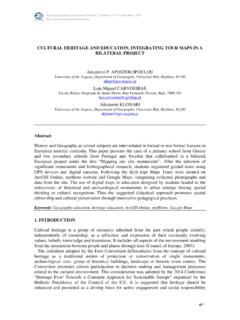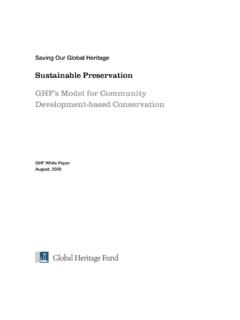Transcription of PLANNING FOR CONSERVATION OF HERITAGE AREAS IN
1 1 Chapter 1 Introduction The chapter one deals with the HERITAGE concepts, statement of problem, importance of CONSERVATION of HERITAGE AREAS , need for study, aim and objectives, methodology , scope, limitations and organisation of the thesis for undertaking research work in the HERITAGE City of Mysore, Background India has a long history of human habitation and it has inherited enormous wealth of built HERITAGE . Both built and natural HERITAGE have crucial links between the past and the present and they play a crucial role in shaping the urban structure and built form.
2 Built HERITAGE provides us with vital information and know how about the ancient culture, way of life, level of development, building techniques, use of material, art and architecture and other AREAS concerning physical, social, economic aspects of a society of a particular period. Therefore, it becomes necessary to appraise the repository of knowledge of HERITAGE structures, which are to be carefully preserved, conserved and managed appropriately. HERITAGE is a broad concept which includes the cultural as well as the natural environment. It encompasses built environments, historic places, sites, landscapes as well as biodiversity, knowledge collections, past and continuing cultural practices including living experiences.
3 It is a dynamic reference point and positive instrument for growth and change. The collective memory of each locality or community or a particular HERITAGE is unique. The protection, CONSERVATION , interpretation and presentation of the HERITAGE and cultural diversity of any particular place are important challenges for planners. Manmade structures of historic and architectural significance have become a part of the cultural HERITAGE of any city and the society. In this regard, the preservation of historical structures has to have an objective of safeguarding national cultural identity.
4 Owing to rapidly modernizing built environment, there is a need for devoting attention to preserve the cultural and architectural HERITAGE , before it disappears 2 completely. Buildings and AREAS of historic or architectural value in all cities are disappearing very fast due to neglect and decay or deliberate demolitions results in changing the specific characters of city centres, leading to monotonous and incongruent new modern constructions. HERITAGE CONSERVATION and modernity are not necessarily in opposition. Rather they are inseparably linked in what Clifford Geertz describes as the dialectical relationship between the search for identity which looks back to the past, and the forward - looking modernity of demand for progress with increasing globalization.
5 The search for identity may be expected to play a larger role in harmonious urban development, bringing both economic growth and employment. The appropriation of economic benefits from CONSERVATION is a long standing feature of the HERITAGE CONSERVATION movement (Belinda Yuen, 2005). Conserving the unprotected architectural HERITAGE AREAS and sites ensures that the survival of the countries sense of history and its very much character in a globalizing environment. It also offers the opportunity not only to conserve the past, but also to define the future.
6 It provides alternate avenues for employment and a parallel market for local building materials and technologies. In India, CONSERVATION cannot be seen in isolation either as a subject or as an activity. CONSERVATION of architectural HERITAGE acts as preservation of templates in the museum of world cultures. The majority of India s architectural HERITAGE AREAS /sites are unprotected. They constitute a unique civilization legacy, as valuable as the monuments legally protected by Archaeological Survey of India (ASI) or State Archaeological Department and other governmental and non-governmental agencies.
7 This legacy is being steadily eroded as a result of insensitive modernization and urbanization, and the fact that it does not command the same respect as legally protected monuments. Many unprotected HERITAGE AREAS /sites are still in use, and the manner in which they continue to be kept in use represents the living HERITAGE of India. This HERITAGE is manifest in both tangible and intangible forms, and in its diversity defines the composite culture of the country. Beyond its role as a historic document, the unprotected HERITAGE embodies the values of enduring relevance to contemporary Indian society, thus making it worthy of CONSERVATION .
8 These living heritages are not legally protected. The buildings and sites are subject to demolition or 3 unsympathetic interventions. The knowledge of traditional building skills with which it is associated is also in danger of being lost in the absence of patronage and official recognition. Conserving the living HERITAGE , therefore, offers the potential to conserve both traditional buildings and traditional ways of building. The definitions and views of various scholars in the concerned field who have expressed their views regarding the HERITAGE CONSERVATION as follows: The Town and Country PLANNING Act, 1961 defines the HERITAGE buildings as a building possessing architectural, aesthetic, historic or cultural values which is declared as HERITAGE building by the PLANNING Authority or any other competent authority within whose jurisdiction such building is situated.
9 And HERITAGE precinct as an area comprising HERITAGE building or buildings and precincts thereof or related places declared as such by the PLANNING Authority or any other Competent Authority within whose jurisdiction such area is situated. As per the UNESCO s definition, the cultural HERITAGE is the entire corpus of material signs, either artistic or symbolic, handed down by the past to each culture and therefore, to the whole of human kind. According to the Indian National Trust for Art and cultural HERITAGE (INTACH), HERITAGE CONSERVATION area is an area of special architectural, historical and cultural interest; the character and appearance of which is desirable to preserve and enhance.
10 These are AREAS which lend a cultural and traditional identity to the locality. Such AREAS can be large or small, whole towns, squares, groups of buildings or streets and gardens. The Commissioner of the Archaeology, Museum and HERITAGE , Government of Karnataka defined the HERITAGE building as a building possessing architectural, aesthetic, historic or cultural values. According to the National Commission on Urbanisation (1988), the urban CONSERVATION would be concern inter-alia with those components of the urban HERITAGE that, (a) possesses architectural, historical and cultural interest; (b) have a special or unique quality or charm that provides distinctiveness either because of its ambience 4 or because of some distinctive activity centred on or associated with the place.



